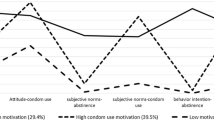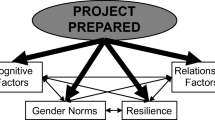Abstract
Background
One in 25 Ugandan adolescents is HIV positive.
Purpose
The aim of this study is to examine the impact of an Internet-based HIV prevention program on Information-Motivation-Behavioral skills (IMB) Model-related constructs.
Methods
Three hundred and sixty-six sexually experienced and inexperienced students 13–18+ years old in Mbarara, Uganda, were randomly assigned to the five-lesson CyberSenga program or the treatment-as-usual control group. Half of the intervention participants were further randomized to a booster session. Assessments were collected at 3 and 6 months post-baseline.
Results
Participants’ HIV-related information improved over time at a greater rate for the intervention groups compared to the control group. Motivation for condom use changed to a greater degree over time for the intervention group—especially those in the intervention + booster group—compared to the control group. Behavioral skills for condom use, and motivation and behavioral skills for abstinence were statistically similar over time for both groups.
Conclusions
CyberSenga improves HIV preventive information and motivation to use condoms.


Similar content being viewed by others
References
UNAIDS. Global report: UNAIDS report on the global AIDS epidemic 2010. Available at http://www.unaids.org/globalreport/documents/20101123_GlobalReport_full_en.pdf. Accessibility verified November 12, 2014.
Uganda Ministry of Health. Uganda AIDS Indicator Survey 2011. Available at http://www.measuredhs.com/pubs/pdf/AIS10/AIS10.pdf. Accessibility verified November 12, 2014.
Uganda AIDS Commission. Global AIDS response progress report: Uganda. Available at http://www.unaids.org/sites/default/files/en/dataanalysis/knowyourresponse/countryprogressreports/2012countries/ce_UG_Narrative_Report%5B1%5D.pdf. Accessibility verified November 12, 2014.
Johnson WD, Diaz RM, Flanders WD, et al. Behavioral interventions to reduce risk for sexual transmission of HIV among men who have sex with men. Cochrane Database Syst Rev. 2008: CD001230.
Fisher JD, Fisher WA. Theoretical approaches to individual-level change in HIV risk behavior. In: Peterson JL, DiClemente RJ, eds. Handbook of HIV Prevention. New York: Kluwer Academic/Plenum Press; 2000: 3-55.
Fisher JD, Fisher WA. Changing AIDS-risk behavior. Psychol Bull. 1992; 111: 455-474.
Fisher JD, Fisher WA. The information-motivation-behavioral skills model. In: DiClemente RJ, Crosby RA, Kegler MC, eds. Emerging theories in health promotion practice and research: Strategies for improving public health. San Francisco: Jossey-Bass; 2002: 40-70.
Fisher CM. Adapting the information-motivation-behavioral skills model: Predicting HIV-related sexual risk among sexual minority youth. Health Educ Behav. 2012; 39: 290-302.
Bazargan M, Stein JA, Bazargan-Hejazi S, Hindman DW. Using the information-motivation behavioral model to predict sexual behavior among underserved minority youth. J Sch Health. 2010; 80: 287-295.
Fisher JD, Fisher WA, Williams SS, Malloy TE. Empirical tests of an information-motivation-behavioral skills model of AIDS-preventive behavior with gay men and heterosexual university students. Health Psychol. 1994; 13: 238-250.
Kalichman SC, Picciano JF, Roffman RA. Motivation to reduce HIV risk behaviors in the context of the Information, Motivation and Behavioral Skills (IMB) model of HIV prevention. J Health Psychol. 2008; 13: 680-689.
Walsh J, Senn T, Scott-Sheldon L, Vanable P, Carey M. Predicting condom use using the Information-Motivation-Behavioral Skills (IMB) model: A multivariate latent growth curve analysis. Ann Behav Med. 2011; 42: 235-244.
Anderson ES, Wagstaff DA, Heckman TG, et al. Information-Motivation-Behavioral Skills (IMB) Model: Testing direct and mediated treatment effects on condom use among women in low-income housing. Ann Behav Med. 2006; 31: 70-79.
Maticka-Tyndale E, Tenkorang EY. A multi-level model of condom use among male and female upper primary school students in Nyanza, Kenya. Soc Sci Med. 2010; 71: 616-625.
Bryan AD, Fisher JD, Benziger TJ. HIV prevention information, motivation, behavioral skills and behaviour among truck drivers in Chennai, India. AIDS. 2000; 14: 756-758.
Linn JG, Garnelo L, Husaini BA, Brown C, Benzaken AS, Stringfield YN. HIV prevention for indigenous people of the Amazon basin. Cell Mol Biol (Noisy-le-grand). 2001; 47: 1009-1015.
Yang X, Xia G, Li X, Latkin C, Celentano D. Social influence and individual risk factors of HIV unsafe sex among female entertainment workers in China. AIDS Educ Pre. 2010; 22: 69-86.
Kalichman SC, Simbayi LC, Cain D, Jooste S, Skinner D, Cherry C. Generalizing a model of health behaviour change and AIDS stigma for use with sexually transmitted infection clinic patients in Cape Town, South Africa. AIDS Care. 2006; 18: 178-182.
Malow RM, Stein JA, McMahon RC, Dévieux JG, Rosenberg R, Jean-Gilles M. Effects of a culturally adapted HIV prevention intervention in Haitian youth. J Assoc Nurses AIDS Care. 2009; 20: 110-121.
Fisher JD, Fisher WA, Bryan AD, Misovich SJ. Information-motivation-behavioral skills model-based HIV risk behavior change intervention for inner-city high school youth. Health Psychol. 2002; 21: 177-186.
Ybarra ML, Eaton WW. Internet-based mental health interventions. Ment Health Serv Res. 2005; 7: 75-87.
Monico SM, Tanga EO, Nuwagaba A, Aggleton P, Tyrer P. Uganda: HIV and AIDS-related discrimination, stigmatization, and denial. Available at http://data.unaids.org/publications/irc-pub02/jc590-uganda_en.pdf. Accessibility verified November 12, 2014.
Blum RW. Uganda AIDS prevention: A, B, C and politics. J Adolesc Health. 2004; 34: 428-432.
Kiapi-Iwa L, Hart GJ. The sexual and reproductive health of young people in Adjumani district, Uganda: Qualitative study of the role of formal, informal, and traditional health providers. AIDS Care. 2004; 16: 339-347.
Ybarra ML, Kiwanuka J, Emenyonu N, Bangsberg DR. Internet use among Ugandan adolescents: Implications for HIV intervention. PLoS Med. 2006; 3: e433.
Ybarra ML, Korchmaros J, Kiwanuka J, Bangsberg D, Bull S. Examining the applicability of the IMB model in predicting condom use among sexually active secondary school students in Mbarara, Uganda. AIDS Behav. 2012; 17: 1116-1128.
Ybarra ML, Biringi R, Prescott T, Bull SS. Usability and navigability of an HIV/AIDS internet intervention for adolescents in a resource-limited setting. Comput Inform Nurs. 2012; 30: 587-595.
Bull S, Nabembezi D, Birungi R, Kiwanuka J, Ybarra ML. Cyber-Senga: Ugandan youth preferences for content in an internet-delivered comprehensive sexuality education programme. East Afr J Publ Health. 2010; 7: 58-63.
Katz IT, Ybarra ML, Wyatt MA, Kiwanuka JP, Bangsberg DR, Ware NC. Socio-cultural and economic antecedents of adolescent sexual decision-making and HIV-risk in rural Uganda. AIDS Care. 2013; 25: 258-264.
Ybarra ML, Bull SS, Prescott TL, Korchmaros JD, Bangsberg DR, Kiwanuka JP. Adolescent abstinence and unprotected sex in CyberSenga, an Internet-based HIV prevention program: Randomized clinical trial of efficacy. PLoS ONE. 2013; 8: e70083.
Smith LC, Ruel MT, Ndiaye A. Why is child malnutrition lower in urban than in rural areas? Evidence from 36 developing countries. Available at http://www.ifpri.org/sites/default/files/publications/fcndp176.pdf. Accessibility verified November 12, 2014.
Gakidou E, Cowling K, Lozano R, Murray C. Increased educational attainment and its effect on child mortality in 175 countries between 1970 and 2009: A systemic analysis. Lancet. 2010; 376: 959-974.
Bryan A, Aiken L, West S. HIV/STD risk among incarcerated adolescents: Optimism about the future and self-esteem as predictors of condom use self-efficacy. J Appl Soc Psychol. 2004; 34: 912-936.
Bryan A, Kagee A, Broaddus M. Condom use among South African adolescents: Developing and testing theoretical models of intentions and behavior. AIDS Behav. 2006; 10: 387-397.
Puffer E, Meade C, Drabkin A, Broverman S, Ogwang-Odhiambo R, Sikkema K. Individual- and family-level psychosocial correlates of HIV risk behavior among youth in rural Kenya. AIDS Behav. 2010; 15: 1264-1274.
Uganda Bureau of Statistics. 2010 Statistical Abstract. Available at http://www.ubos.org/onlinefiles/uploads/ubos/pdf%20documents/2010StatAbstract.pdf. Accessibility verified November 12, 2014.
Muyinda H, Nakuya J, Whitworth JAG, Pool R. Community sex education among adolescents in rural Uganda: Utilizing indigenous institutions. AIDS Care. 2004; 16: 69-79.
Central Intelligence Agency. The World Factbook: Uganda. Available at https://www.cia.gov/library/publications/the-world-factbook/geos/ug.html. Accessibility verified November 12, 2014.
Ybarra ML, Bull SS, Prescott TL, Birungi R. Acceptability and feasibility of CyberSenga: An Internet-based HIV-prevention program for adolescents in Mbarara, Uganda. AIDS Care. 2014; 26: 441-447.
Misovich SJ. The Teen Health Survey. Available at http://www.chip.uconn.edu/chipweb/documents/Research/M_IMBTeenHealthSurvey.pdf. Accessibility verified November 12, 2014.
Uganda Bureau of Statistics (UBOS), ORC Macro: Uganda Demographic and Health Survey 2006. Calverton, MD: UBOS and Macro International Inc., 2007.
Zimet GD, Dahlem NW, Zimet SG, Farley GK. The multidimensional scale of perceived social support. J Pers Assess. 1988; 52: 30-41.
Ware JE, Kosinski M. SF-36 Physical and Mental Health Summary Scales: A Manual for Users of Version 1. Lincoln, RI: QualityMetric Inc.; 2001.
Rosenberg M. Society and the adolescent self-image. Princeton: Princeton University Press; 1965.
StataCorp: Stata Statistical Software. College Station, TX: StataCorp LP, 2009.
Rubin DB. Multiple imputation for nonresponse in surveys. New York: Wiley; 1987.
Hendriksen ES, Pettifor A, Lee SJ, Coates T, Rees H. Predictors of condom use among young adults in South Africa: The reproductive health and HIV research unit national youth survey. Am J Public Health. 2007; 97: 1241-1248.
Acknowledgments
We would like to thank the entire CyberSenga Study team from Internet Solutions for Kids; Internet Solutions for Kids, Uganda; Mbarara University of Science and Technology; the University of Colorado; and Harvard University, who contributed to the planning and implementation of the study. Finally, we thank the schools and the students for their time and willingness to participate in this study.
Funding
The project described was supported by Award Number R01MH080662 from the National Institute of Mental Health. The clinic trial registration number is NCT00906178. The content is solely the responsibility of the authors and does not necessarily represent the official views of the National Institute of Mental Health or the National Institutes of Health.
Conflict of Interest and Adherence to Ethical Standards
Authors Ybarra, Korchmaros, Prescott, and Birungi declare that they have no conflict of interest. All procedures, including the informed youth assent and parent permission process, were conducted in accordance with the ethical standards of the responsible committee on human experimentation (institutional and national) and with the Helsinki Declaration of 1975, as revised in 2000.
Author information
Authors and Affiliations
Corresponding author
About this article
Cite this article
Ybarra, M.L., Korchmaros, J.D., Prescott, T.L. et al. A Randomized Controlled Trial to Increase HIV Preventive Information, Motivation, and Behavioral Skills in Ugandan Adolescents. ann. behav. med. 49, 473–485 (2015). https://doi.org/10.1007/s12160-014-9673-0
Published:
Issue Date:
DOI: https://doi.org/10.1007/s12160-014-9673-0




